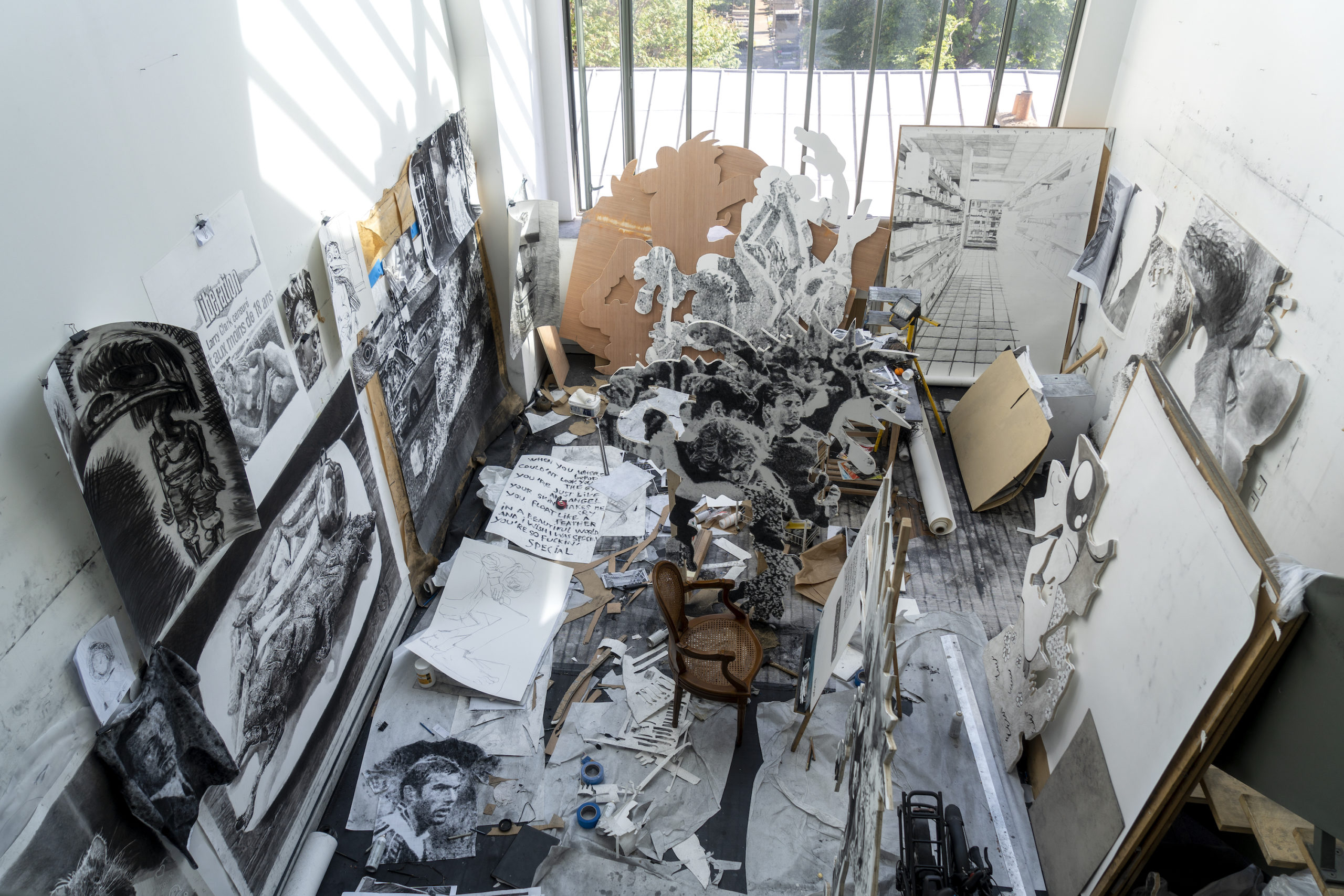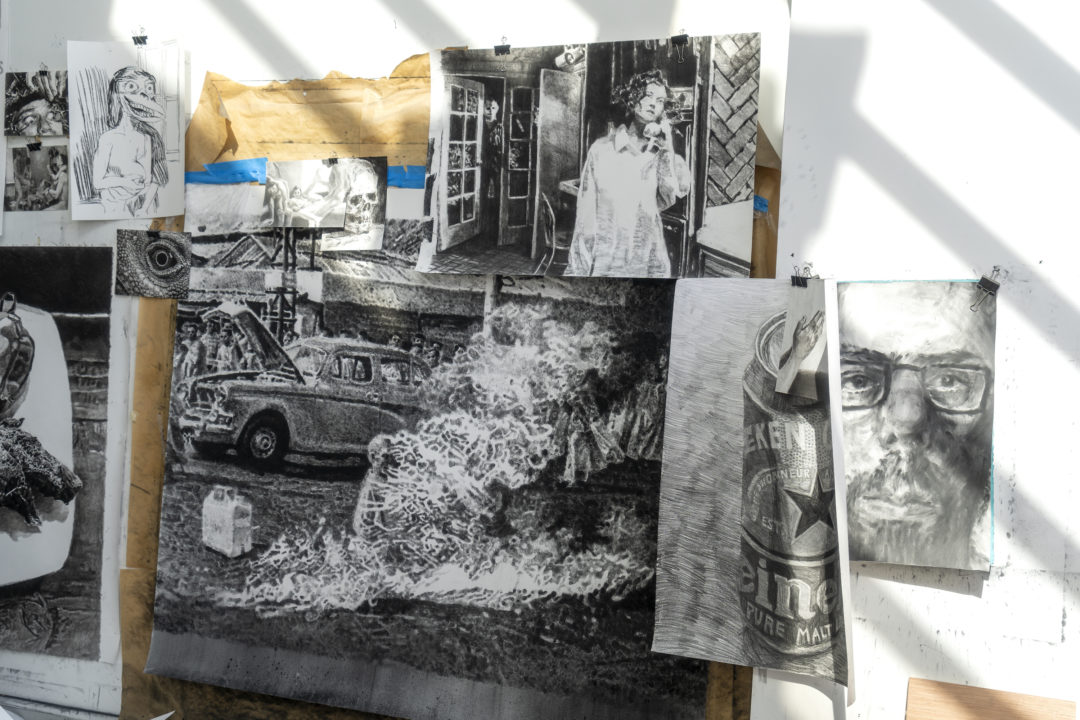Jérôme Zonder at Casino Luxembourg

Jérôme Zonder, « Joyeuse Apocalypse ! »,
Casino Luxembourg, 7.10.23-7.1.2024
Give Jérôme Zonder a space the size of a ballroom, with its antechamber and annexes, and he will fill it with drawings, as parts and as a whole, working on the walls, the floors, in the nooks and crannies, with cut-outs and assemblages, themselves drawing in the space and blending with texts that are also images… With him, the list of types of drawings that can interact seems endless.

© Marc Domage – Courtesy de l’artiste et de la Galerie Nathalie Obadia Paris/Bruxelles.
At the invitation of Kevin Muhlen at Casino Luxembourg, the artist is continuing along this path, which he has begun to explore over the last few exhibitions, using techniques that vary according to the subjects and the affects they convey, while the hanging creates an environment that is linked, in a flexible yet assertive way, to a narrative: in this case, an episode in the life of a young man called Pierre-François (after one of the characters in Marcel Carné’s 1945 film Les Enfants du paradis ), born in 2000. What does this mean? The “Joyeuse Apocalypse” exhibition lets us discover the world through his eyes, this invented character, but one we could very well have come across somewhere, following his tastes and habits. We meet him now, in the year he turns 23, at the climax of a party that echoes the history of the Casino, a former reception venue for European high society built at the end of the 19th century, but also another exhibition whose title and location at the crossroads of two eras it evokes: “Vienna 1880-1938. L’apocalypse joyeuse”, at the Centre Pompidou in 1986.
Is Pierre-François, who has reached the age of the century, inviting us to dance to celebrate the end of something?
The images that populate his mind come from the Internet, of course. For example, he looks at and posts images of cute animals, such as the magnificent little hamster and its 206 K ♡, drawn by Zonder in a realistic style and used on the cover of the exhibition leaflet. In the galleries, he hangs in a large jumble where he rubs shoulders with figures of footballers, a supermarket aisle, slogans, and then Alex, from Clockwork Orange, of whom Pierre-François is a toned-down version, living out his adventures on his phone and games consoles. On a second large wall, another rodent is making eyes at us, this one taken from a cartoon. Related to Pikachu and other legendary creatures that are part of the imagination of a whole generation, it stands next to the stylised M of McDonald’s, accompanied by the slogan “Come as you are” which, in this situation, reads like a humorous comment, while, not far away, the highlighted lyrics of a Radiohead song, selected for cut-and-paste or “ready-to-sing”, in the spirit of karaoke, add a melody to the hubbub of the images. And then, paintings, Zonder’s references, are introduced into the mural composition, again via the fiction of the character who, presumably, between an advert and a YouTube video, might have stumbled across a vanitas or a seventeenth-century religious painting. This mix means that the overall tone of this exhibition is gentler than previous ones, where the drawings showed children haunted by nightmares reflecting the horrors of history. Here, the world around Pierre-François, now an adult, affects him; the cause is screens, or at least filtered representations, so that all the content we are shown is smoothed out, placed end to end on the same level. Zonder’s drawing is particularly effective from this point of view: it conveys the way in which the images, in their very heterogeneity, become completely amalgamated and end up forming a system between them, with no off-screen. Moreover, in a construction made up of panels cut out in the middle of the ballroom, Pierre-François himself becomes a cartoon character, in the playful form of an optical game. The tone is not optimistic, however. In a small adjoining room, we can jump from one square to another in a game of goose (or a comic strip) that recounts moments in Pierre-François’s life in a joking, self-deprecating way. The lines drawn on the floor gradually blur as we pass, while the walls are covered from top to bottom with thumbprints of varying degrees of intensity, creating a landscape of pointillist mist that leaves us without landmarks, without a horizon. So here it is, the joyous apocalypse at its heart. It’s a game, with laughter, dancing, songs, everything’s fine, except that the outcome, if there is one, is even better hidden than in an escape game.

Courtesy de l’artiste et de la Galerie Nathalie Obadia Paris/Bruxelles.
1 Ce personnage est déjà apparu dans d’autres expositions – notamment « Fatum »à La Maison Rouge, à Paris, en 2015 –, essentiellement conçues autour de sa sœur, Garance ; si bien qu’au Casino, on pénètre, en quelque sorte, dans la suite d’une « saga » familiale. Mais les meilleures sagas commencent aussi bien par les épisodes du milieu, n’est-ce pas ?
______________________________________________________________________________
Head image : Vue atelier Jérôme Zonder 2023
© Marc Domage – Courtesy de l’artiste et de la Galerie Nathalie Obadia Paris/Bruxelles.
- From the issue: 107
- Share: ,
- By the same author: Alias at M Museum, Leuven, Nathaniel Mellors, ELNINO76, Yannick Ganseman*, Théo-Mario Coppola,
Related articles
Performa Biennial, NYC
by Caroline Ferreira
Camille Llobet
by Guillaume Lasserre
Thomias Radin
by Caroline Ferreira